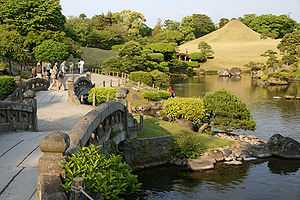Suizen-ji Jōju-en

Suizen-ji Jōju-en (水前寺成趣園) is a tsukiyama[1] Japanese garden located within (Suizen-ji Park (水前寺公園 Suizen-ji Kōen) in Kumamoto Prefecture, Japan. The main tsukiyama is a representation of Mount Fuji. Lord Hosokawa Tadatoshi began construction of the garden in 1636 as a tea retreat. The park was named after a no-longer-extant Buddhist temple called Suizen-ji, and now hosts the Izumi Shrine, where members of the Hosokawa family are enshrined, and a Nōgaku-dō, a Noh theater. Lord Hosokawa selected this site because of its spring-fed pond, which clean water was excellent for tea.[2] The thatched Kokin-Denju-no-Ma teahouse was originally in Kyoto's Imperial Palace, but was moved here in 1912.
The garden has been declared by the national government a historic site of scenic beauty.
Suizenji Park
Suizenji Kōen is an interesting and much visited venue, featuring miniature landscapes, a temple and small lakes containing large, hungry, and multi-coloured carp. It is a short tram ride from the city. Nearby, there are many omiyage and snack shops.
See also
Gallery
-
The pond
-

The pond
-

The Kokin-Denju-no-Ma teahouse
-

The Yabusame (horseback archery) riding ground
-

An arched bridge
-

Replica of Mount Fuji
-

Izumi Shrine
-
A large carp in the park
-

Statue of Hosokawa Tadatoshi
Notes
- ↑ Tsukiyama gardens are Japanese gardens featuring an artificial mountain (a tsukiyama).
- ↑ "Pylant, Don D. Japanese Gardening Organization - Suizenji Park". Botanysaurus. 2001-10-11. Retrieved 2008-07-23.
References
- Explore Japan, Suizenji Garden accessed on August 31, 2009
| Wikimedia Commons has media related to Suizenji-jojuen. |
Bibliography
Mansfield, Stephen (2011). Japan's Master Gardens - Lessons in Space and Environment (Hardback). Tokyo, Rutland, Singapore: Tuttle. ISBN 978-4-8053-1128-8.
Coordinates: 32°47′27.93″N 130°44′4.54″E / 32.7910917°N 130.7345944°E

